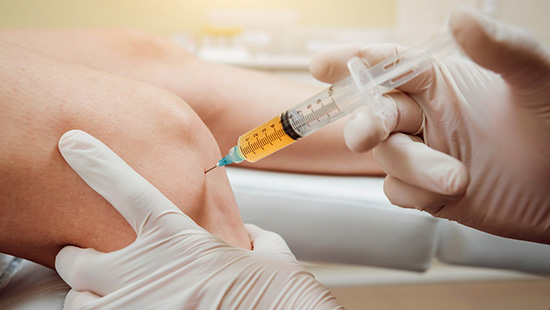Regenerative Medicine

Regenerative medicine is a strategy to use the body’s own healing powers to treat injuries and conditions.
Regenerative medicine procedures target the tissue that has been damaged by injury or disease and works by enhancing the effectiveness of the body’s natural healing process.
The goal is to relieve pain and restore function lost due to age, injury, disease or damage.
Doctors at the University of Maryland Medical System are experts in the full spectrum of regenerative medicine options. We offer regenerative therapies for sports injuries and musculoskeletal conditions including tendinitis, arthritis, tendon or muscle strains, and joint or ligament sprains. We work with you to customize a treatment plan best suited to your needs.
Regenerative medicine is not a substitute for treatments such as rest, bracing, taping, or physical therapy. Traditional therapies and regenerative medicine are often combined to optimize healing.
Platelet-Rich Plasma Injection
Although mainly liquid, or plasma, blood is also made of red cells, white cells and platelets. Platelets help blood clot but also contain proteins called growth factors, which help heal injuries.
PRP uses the patient’s blood to make a plasma solution with a high concentration of platelets. To speed healing, PRP can be injected into an injured area, such as an inflamed Achilles tendon. It can take several weeks for beneficial results. We can also use PRP-infused sutures on torn tendons to speed healing after surgery.
Prolotherapy
Prolotherapy, or proliferative therapy, is an outpatient treatment that can provide patients with long-lasting pain relief compared to the temporary relief steroid injections provide.
A mixture of dextrose (sugar), saline (salt water) and lidocaine (numbing medication) is injected into a joint, muscle, tendon or ligament. This stimulates the repair of tissue damaged by arthritis, strains or sprains. Prolotherapy does not require surgery, anesthesia or an extended recovery period.
Amniotic Membrane Injection
Amniotic membrane tissue is now available for injection into joints and soft tissue. This nutrient-rich placental tissue supports fetus development during pregnancy. It is collected from donor placentas after planned caesarian sections.
Although it has no living cells, amniotic membrane tissue contains more than 225 natural growth factors, cytokines, chemokines and collagens. These help the body regulate inflammation and boost healing of musculoskeletal injuries.
Amniotic membrane tissue injections are an alternative to platelet-rich plasma, especially in older adults whose blood may not have robust healing factors. An outpatient procedure, one injection usually offers significant results, although some patients may need follow-up injections. The injection may cause minor pain, but patients can usually return to normal activities the same day.
Fat Injection
Fat, or adipose tissue, contains healing factors and reparative cells that are useful for healing injuries. Collected from your own body, fat cells can be injected to treat several orthopedic conditions.
Fat tissue maintains its healing properties as we age, making it a treatment option for all patients. An outpatient procedure, one injection can have significant results, but some patients may need follow-up injections. While fat injection may cause minor discomfort, patients can usually return to normal activities the same day.
Official Medical Provider For


